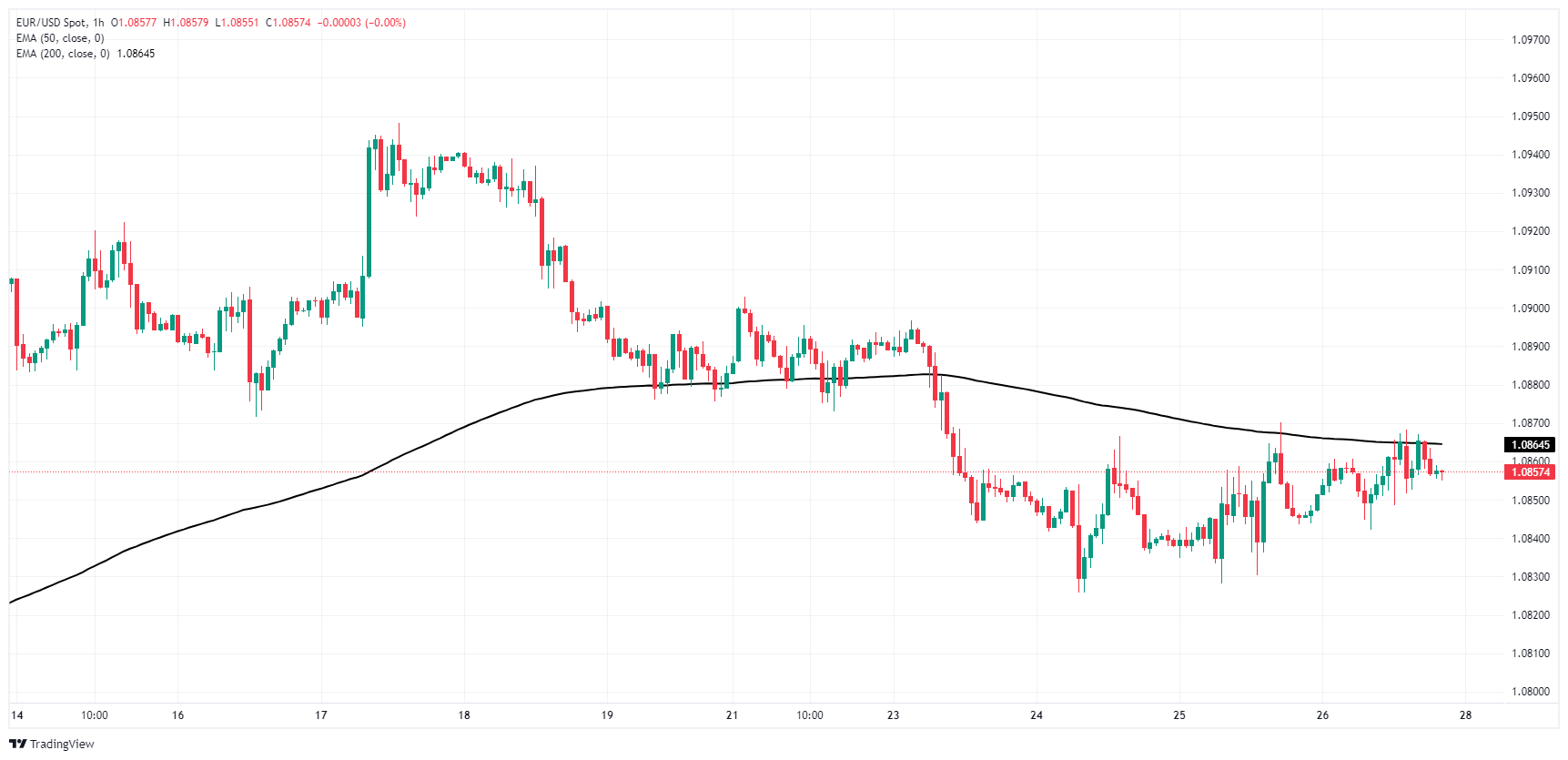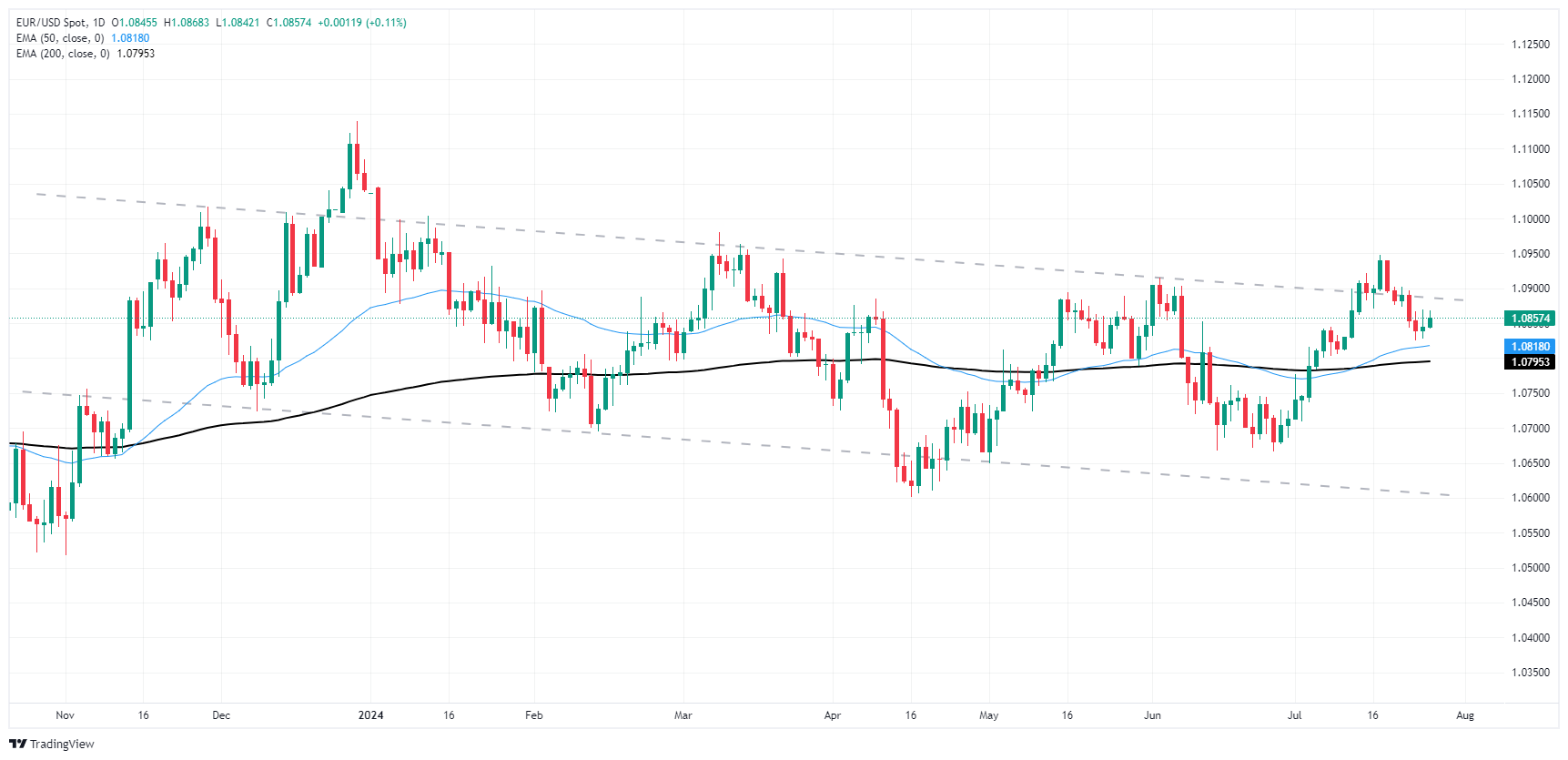- Analiza
- Novosti i instrumenti
- Vesti sa tržišta
- EUR/USD finds thin Friday gains but still trapped below 1.09
EUR/USD finds thin Friday gains but still trapped below 1.09
- EUR/USD gained a little ground on Friday, but still down for the week.
- Market sentiment continues to get lead by Fed rate cut hopes.
- Key EU inflation data due next week ahead of next Fed rate call.
EUR/USD found a slim foothold on Friday, rising one-fifth of one percent at the bell but still ending the overall week in the red, adding into a two-week decline of around 1.12% top-to-bottom. The Fiber continues to churn as investors get ready for another rate call from the Federal Reserve (Fed) and a key update on European inflation figures as Euro traders try to weigh the odds of another European Central Bank (ECB) rate trim.
Forecasting the Coming Week: All eyes are on the Fed’s decision and the NFP
Coming up next week, key pan-EU Harmonized Index of Consumer Prices (HICP) inflation figures will drop on Wednesday, giving investors a key look into when they could expect a follow-up rate cut from the ECB after policymakers gave a 25 basis point trim in June. EU-wide headline HICP inflation for the year ended in July is expected to ease to 2.3% from the previous 2.5% YoY.
On the US side, the Fed will also give its latest rate call slated for Wednesday. The US central bank is broadly expected to keep rates on hold in July, but investors will be watching for any large shifts in rhetoric from policymakers. Next Friday will also see US Nonfarm Payrolls, a key data point for pricing out odds of a September rate call.
The underlying US PCE inflation remained unchanged at 2.6% on an annualized basis in June, defying the median market expectations of a slight decrease to 2.5%. Short-term PCE inflation also picked up in June, increasing to 0.2% from the anticipated 0.1%.
The University of Michigan's (UoM) Consumer Sentiment Index dropped to 66.4 in July, marking an eight-month low, which was less of a decline than the expected 66.0, but still lower than the previous 68.4. Additionally, UoM 5-year Consumer Inflation Expectations rose to 3.0% in July, up from the previous 2.9%.
Despite the various indications pointing towards a potential increase in inflationary pressures, the market concluded on Friday that the data did not warrant significant concern. As a result, market sentiment shifted back towards riskier assets, and hopes for a rate cut in September persisted. According to the CME's FedWatch Tool, the rate markets are still pricing in an unchanged stance from the Federal Open Market Committee (FOMC) on July 31, with a 100% likelihood of at least a 25-basis-point cut on September 18. There is also a segment of market participants showing optimism for a double cut in September, with a 12% probability of a 50 basis points reduction.
Euro PRICE This week
The table below shows the percentage change of Euro (EUR) against listed major currencies this week. Euro was the strongest against the Australian Dollar.
| USD | EUR | GBP | JPY | CAD | AUD | NZD | CHF | |
|---|---|---|---|---|---|---|---|---|
| USD | 0.24% | 0.36% | -2.29% | 0.87% | 2.11% | 2.20% | -0.44% | |
| EUR | -0.24% | 0.10% | -2.55% | 0.58% | 1.90% | 1.87% | -0.74% | |
| GBP | -0.36% | -0.10% | -2.75% | 0.46% | 1.80% | 1.76% | -0.88% | |
| JPY | 2.29% | 2.55% | 2.75% | 3.27% | 4.57% | 4.52% | 1.80% | |
| CAD | -0.87% | -0.58% | -0.46% | -3.27% | 1.32% | 1.30% | -1.32% | |
| AUD | -2.11% | -1.90% | -1.80% | -4.57% | -1.32% | -0.03% | -2.63% | |
| NZD | -2.20% | -1.87% | -1.76% | -4.52% | -1.30% | 0.03% | -2.56% | |
| CHF | 0.44% | 0.74% | 0.88% | -1.80% | 1.32% | 2.63% | 2.56% |
The heat map shows percentage changes of major currencies against each other. The base currency is picked from the left column, while the quote currency is picked from the top row. For example, if you pick the Euro from the left column and move along the horizontal line to the US Dollar, the percentage change displayed in the box will represent EUR (base)/USD (quote).
EUR/USD technical outlook
Despite finding a slim foothold and etching in a thin gain on Friday, the Fiber remains on the low side of a descending channel on daily candlesticks as bulls struggle to find momentum. Overall trend odds lean in favor of buyers as price action continues to hold above the 200-day Exponential Moving Average (EMA) at 1.0795, but upside chances are evaporating as EUR/USD slides back from recent peaks that failed to capture the 1.0950 level.
With the pair’s last major swing low priced in around the 1.0700, it’s bidders’ game to lose as short pressure continues to build up and try to drag EUR/USD back into the low side.
EUR/USD hourly chart
EUR/USD daily chart
Euro FAQs
The Euro is the currency for the 20 European Union countries that belong to the Eurozone. It is the second most heavily traded currency in the world behind the US Dollar. In 2022, it accounted for 31% of all foreign exchange transactions, with an average daily turnover of over $2.2 trillion a day. EUR/USD is the most heavily traded currency pair in the world, accounting for an estimated 30% off all transactions, followed by EUR/JPY (4%), EUR/GBP (3%) and EUR/AUD (2%).
The European Central Bank (ECB) in Frankfurt, Germany, is the reserve bank for the Eurozone. The ECB sets interest rates and manages monetary policy. The ECB’s primary mandate is to maintain price stability, which means either controlling inflation or stimulating growth. Its primary tool is the raising or lowering of interest rates. Relatively high interest rates – or the expectation of higher rates – will usually benefit the Euro and vice versa. The ECB Governing Council makes monetary policy decisions at meetings held eight times a year. Decisions are made by heads of the Eurozone national banks and six permanent members, including the President of the ECB, Christine Lagarde.
Eurozone inflation data, measured by the Harmonized Index of Consumer Prices (HICP), is an important econometric for the Euro. If inflation rises more than expected, especially if above the ECB’s 2% target, it obliges the ECB to raise interest rates to bring it back under control. Relatively high interest rates compared to its counterparts will usually benefit the Euro, as it makes the region more attractive as a place for global investors to park their money.
Data releases gauge the health of the economy and can impact on the Euro. Indicators such as GDP, Manufacturing and Services PMIs, employment, and consumer sentiment surveys can all influence the direction of the single currency. A strong economy is good for the Euro. Not only does it attract more foreign investment but it may encourage the ECB to put up interest rates, which will directly strengthen the Euro. Otherwise, if economic data is weak, the Euro is likely to fall. Economic data for the four largest economies in the euro area (Germany, France, Italy and Spain) are especially significant, as they account for 75% of the Eurozone’s economy.
Another significant data release for the Euro is the Trade Balance. This indicator measures the difference between what a country earns from its exports and what it spends on imports over a given period. If a country produces highly sought after exports then its currency will gain in value purely from the extra demand created from foreign buyers seeking to purchase these goods. Therefore, a positive net Trade Balance strengthens a currency and vice versa for a negative balance.
© 2000-2024. Sva prava zaštićena.
Sajt je vlasništvo kompanije Teletrade D.J. LLC 2351 LLC 2022 (Euro House, Richmond Hill Road, Kingstown, VC0100, St. Vincent and the Grenadines).
Svi podaci koji se nalaze na sajtu ne predstavljaju osnovu za donošenje investicionih odluka, već su informativnog karaktera.
The company does not serve or provide services to customers who are residents of the US, Canada, Iran, The Democratic People's Republic of Korea, Yemen and FATF blacklisted countries.
Izvršenje trgovinskih operacija sa finansijskim instrumentima upotrebom marginalne trgovine pruža velike mogućnosti i omogućava investitorima ostvarivanje visokih prihoda. Međutim, takav vid trgovine povezan je sa potencijalno visokim nivoom rizika od gubitka sredstava. Проведение торговых операций на финанcовых рынках c маржинальными финанcовыми инcтрументами открывает широкие возможноcти, и позволяет инвеcторам, готовым пойти на риcк, получать выcокую прибыль, но при этом неcет в cебе потенциально выcокий уровень риcка получения убытков. Iz tog razloga je pre započinjanja trgovine potrebno odlučiti o izboru odgovarajuće investicione strategije, uzimajući u obzir raspoložive resurse.
Upotreba informacija: U slučaju potpunog ili delimičnog preuzimanja i daljeg korišćenja materijala koji se nalazi na sajtu, potrebno je navesti link odgovarajuće stranice na sajtu kompanije TeleTrade-a kao izvora informacija. Upotreba materijala na internetu mora biti praćena hiper linkom do web stranice teletrade.org. Automatski uvoz materijala i informacija sa stranice je zabranjen.
Ako imate bilo kakvih pitanja, obratite nam se pr@teletrade.global.















